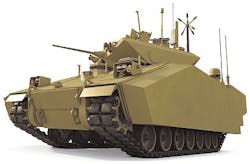Curtiss-Wright to supply vetronics computers and network switches in GCV competition
SANTA CLARITA, Calif., 27 March 2013.Vetronics designers at Northrop Grumman Corp. Information Systems sector in McLean, Va., needed an open-architecture embedded computer and network switch subsystems for the company's version of the U.S. Army Ground Combat Vehicle (GCV). They found their solution from Curtiss-Wright Controls Defense Solutions in Santa Clarita, Calif.
Northrop Grumman awarded a $2.5 million contract to Curtiss-Wright for the mission computer and network switch. Curtiss-Wright announced the contract Monday. The contract has a potential value of more than $250 million over the life of the GCV production phase, which is expected to begin in 2018.
Northrop Grumman is teaming with BAE Systems in a competition to build the Army a next-generation armored personnel carrier. The Northrop Grumman-BAE Systems team is entering a 70-ton armored combat vehicle in the GCV competition. The tracked vehicle can carry infantry squad and three crewmen, and is air-transportable by C-17 and C-5 cargo jets.
The Curtiss-Wright mission computer going onto the BAE Systems-Northrop Grumman entry in the GCV competition uses four commercial off-the-shelf (COTS) single board computers in a rugged chassis.
The chassis is able to cool more than 250 Watts of heat without the use of fans, liquid cooling, or conditioned base plate, company officials say. The company’s rugged network switch provides a network for communications between the mission computer and other devices within the vehicle.
Two teams are competing to build the GCV: a team of BAE Systems, Northrop Grumman, QinetiQ North America, Saft Group, and iRobot; a team of General Dynamics Land Systems, Lockheed Martin, and Raytheon. The program has entered engineering and manufacturing development.
The Army plans to buy more than 1,874 GCVs to replace Bradley Fighting Vehicles. The vehicle will have mature technologies, and will be able to accommodate future growth.
Under the terms of the Northrop Grumman contract to Curtiss-Wright, shipments began in the first quarter of 2012 and are scheduled to continue throughout the remainder of this year. Curtiss-Wright is delivering products to Northrop Grumman in Huntsville, Ala.
The BAE Systems–Northrop Grumman GCV Infantry Fighting Vehicle design modernizes the U.S. Army’s ground combat vehicle fleet with a new hybrid electric drive propulsion system that enables force protection and mobility, while allowing for future growth in power requirements and new technologies, Curtiss-Wright officials say.
The vehicle employs customizable combinations of armor packages on a tough, space efficient steel core hull and features improved fuel efficiency, agility and acceleration due to the electric drive.
The GCV accommodates up-to-date network capability via a open-architecture command, control, communications, computers, intelligence, surveillance, and reconnaissance (C4ISR) and infrastructure system.
For more information contact Curtiss-Wright Controls Defense Solutions online at www.cwcdefense.com, or Northrop Grumman Information Systems at www.northropgrumman.com.
